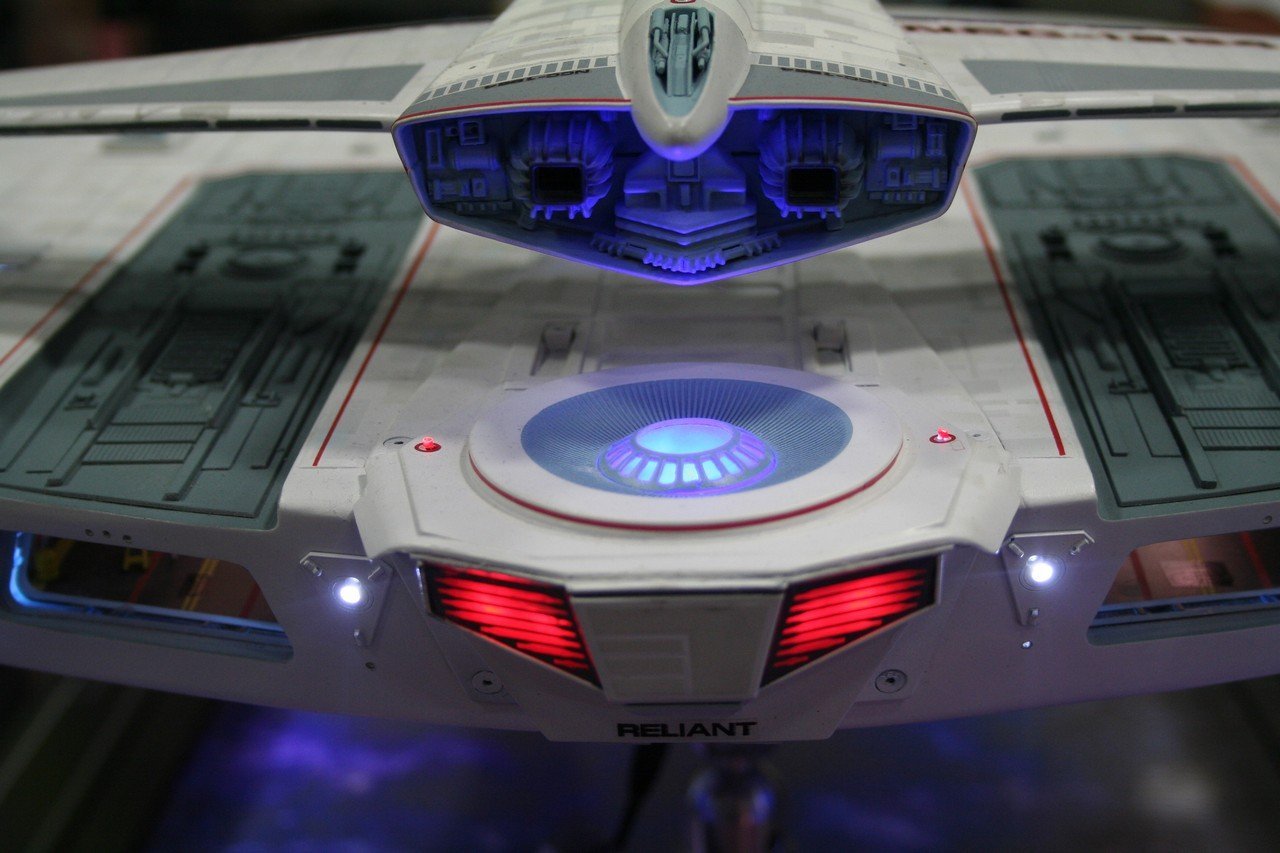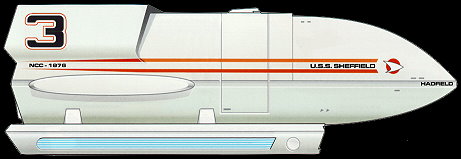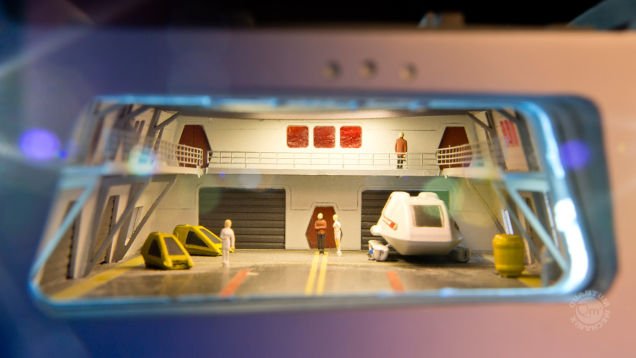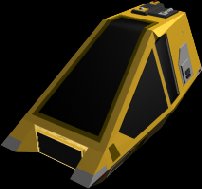

Sheffield has two shuttlebays. The layout for the shuttle and auxiliary craft operations is as follows:
Shuttle control - Deck 4. Flight Operations and Briefing Room - Deck 4.
Operations Centre and Briefing Room - Deck 4.
Senior Flight Officers Quarters - Deck 5.
Junior Flight Officers Quarters - Deck 5.
Little Mester access - Deck 6.
Shuttlecraft access - Deck 6.
Flight Operations and Briefing Room - Deck 4.
Operations Centre and Briefing Room - Deck 4.
Senior Flight Officers Quarters - Deck 5.
Junior Flight Officers Quarters - Deck 5.
Little Mester access - Deck 6.
Shuttlecraft access - Deck 6.
The Sheffield has five shuttles:
 01 Firth - Galileo shuttle named for the Firth Dynasty. Most famous member of the dynasty was Mark Firth [1819 - 1880] who was Master Cutler from 1867 - 69, Mayor in 1875 and benefitted the public with Firth Park and Firth College - later Sheffield University. Length: approx. 9.1m.
01 Firth - Galileo shuttle named for the Firth Dynasty. Most famous member of the dynasty was Mark Firth [1819 - 1880] who was Master Cutler from 1867 - 69, Mayor in 1875 and benefitted the public with Firth Park and Firth College - later Sheffield University. Length: approx. 9.1m.
02 Mappin - Modified Galileo class specialist scientific research shuttle named for Frederick Mappin [1821 - 1910] who came from the famous cutlery family. Mappin was the Midland Railway director, Liberal MP and Mayor 1877. Baronet in 1886 and Sheffield's first honourary Freeman in 1900. Founded the Technical School and Sheffield University. He was the first Senior Pro-Chancellor.
03 Hadfield - Galileo class multi-purpose warp shuttle named for Robert Hadfield [1858 - 1940] who discovered Manganese Steel in 1882, reaffirming Sheffield's position as the best alloy-producer in the world. Length: 9.1m.
04 Sharman - Galileo class multipurpose shuttlecraft named for Britain's first astronaut, Helen Sharman. The Sharman was brought aboard in 2305 to replace the Chisu class shuttlepod Tyzack, which Commander Hawkins believed was insufficient for the role intended for the Sheffield as a primary vessel for exploration and research.
05 Brearley - Aeroshuttle named for Harry Brearley [1871 - 1948] who discovered Stainless Steel in the laboratories of Firth-Brown steelworks in 1913.
All of the shuttlecraft were replaced in 2311 by order of Commander Hawkins. Nathaniel sent his Senior Flight Officer - Lieutenant Henrik Kyrre - to scour the Federation for the finest and most appropriate shuttle and auxiliary craft for the ship, and the mission ahead. All small shuttles of this time are sublight shuttles.
Lt. Kyrre selected one executive Galileo shuttlecraft which was christened Firth. This runabout would be the Captain's Yacht or Gig. This yacht would be used at the Captain's personal discretion and would be for diplomatic missions only [emergencies excepting]. The interior would be fitted out with the most up-to-date diplomatic suite that was available in 2311. The shuttle can carry 6 - 8 passengers and 2 pilots in luxury. This would be for missions of 'showing the flag' when the captain was out to impress the visitors to the ship. Firth therefore became Lt. Kyrre's personal duty. Anytime the Firth is used, excepting illness, Kyrre would be the pilot.
Next was the Mappin, a specialised Galileo class scientific shuttle. This would be the remote scientific eyes and ears of the U.S.S. Sheffield. The shuttle was fitted with the best sensor suite equipment that Starfleet had. Some of the equipment was even classified, Hawkins needed to get permission from Vice Admiral Hudson to have the equipment installed. The Mappin has a crew of approximately three, due to the space taken up by the mission package.
Next were a pair of refurbished Galileo class general purpose shuttlecraft. These hold 6 persons and two pilots. These are the Hadfield and Sharman. These are the most commonly used shuttlecraft, used for any mission that requires crew to be transported from the ship to a base, starship or planet where either the Sheffield cannot be present or transportation is not possible due to shipboard situation or environmental circumstances.
Finally, Brearley. This is the final Galileo class shuttle of the Sheffield.
 In addition to the shuttlecraft there are Work Bee units [idiosyncratically referred to as 'Little Mesters' on the U.S.S. Sheffield], these perform local repair and cargo operations for the Sheffield. These little units bear names from the Little Mesters or independent cutlers who worked in the City of Sheffield.
In addition to the shuttlecraft there are Work Bee units [idiosyncratically referred to as 'Little Mesters' on the U.S.S. Sheffield], these perform local repair and cargo operations for the Sheffield. These little units bear names from the Little Mesters or independent cutlers who worked in the City of Sheffield.
Author's Notes: Each shuttle variant has it's own mission parameters and will therefore come up in stories for different scenarios. I guess it is a little bit like Thunderbirds, where Firefly was used for some missions, The Mole for others. I was unhappy at the notion of Killerbee class assault vessels and Wasp class fighters being on this ship. Starfleet is about peaceful exploration and diplomacy, therefore I strongly believe fighters work against this ethos. I wanted the Sheffield to have some specialised shuttles and yet keeping with what has already been seen onscreen.
Some of the shuttles are for diplomatic missions, others for scientific missions. The Galileo class are the shuttlecraft we are familiar with from Star Trek V, these are the general use shuttles that will be used the most. The Mappin is the modified scientific Galileo class with an AWACS-style disc on the top of the shuttle. 'The Mappin is for mappin' with'. In addition to the disc on the roof, there is specialised scientific equipment crammed inside which limits the room for passengers. This all adds for variety and excitement for the stories. Also means I'll have to be careful which shuttle I choose to do what...









 In addition to the shuttlecraft there are Work Bee units [idiosyncratically referred to as 'Little Mesters' on the U.S.S. Sheffield], these perform local repair and cargo operations for the Sheffield. These little units bear names from the Little Mesters or independent cutlers who worked in the City of Sheffield.
In addition to the shuttlecraft there are Work Bee units [idiosyncratically referred to as 'Little Mesters' on the U.S.S. Sheffield], these perform local repair and cargo operations for the Sheffield. These little units bear names from the Little Mesters or independent cutlers who worked in the City of Sheffield. 


